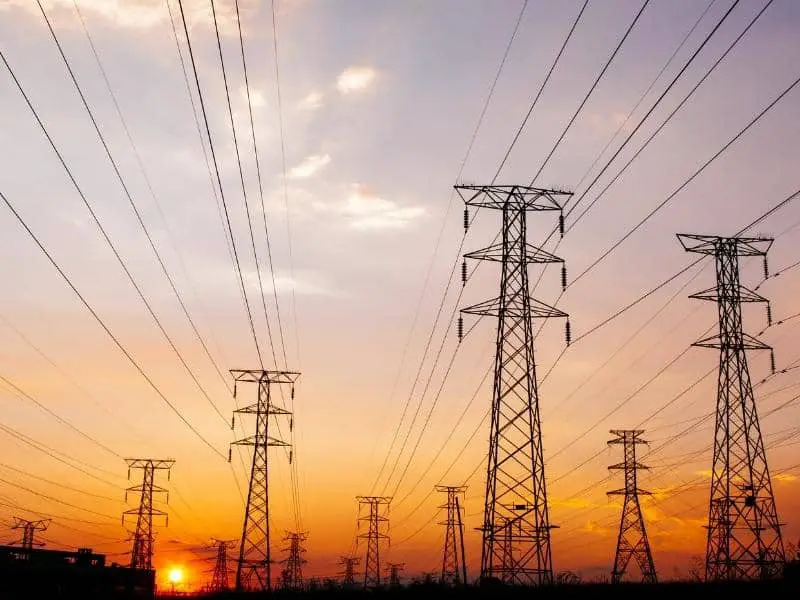Given how dangerous electrical currents can be to human (and animal) health as well as the fire risk that they pose, many people understandably wonder why large above-ground power lines are not insulated.
A few of the key points we’ll cover here include:
• How power lines work
• Efficiency issue with power transmission
• Why power lines aren’t insulated
• Air gaps as de facto insulation
Let’s get into everything you ever wanted to know about power lines, insulation, and how to protect yourself and your loved ones from harm.

Why Are Power Lines Not Insulated?
To effectively insulate these lines, they would require such thick insulation so as to render the process prohibitively expensive;
We’ll cover how transformers massively boost the voltage to increase efficiency and deliver as much electricity as possible to the paying consumers who use it.
Now, let’s move on to the insulation issue: why are these dangerous power lines not insulated, given how charged they are with voltage?
It just wouldn’t make economic sense to cover millions of miles of power lines in insulation that would sufficiently protect against such high-powered electricity.
What Are Power Lines Made of?
Insulation-free power lines typically contain either aluminum wrapped around steel or aluminum itself. Some may also be comprised of carbon and glass fiber, although they are rarer.
Air Gaps: The Alternative Insulation
That might sound dangerous – all those exposed power lines passing enormous loads of electricity all night and day. Isn’t that a recipe for disaster?
Actually, power companies do take some safety precautions. The insulation (which, incidentally, costs them a lot less to install than rubber) that they rely on is called an “air gap.”
“Air gaps” refer to the spaces between power lines filled by, as the name implies, empty air.
Lines are constructed high enough above the ground to stop cars, people, animals (except birds), or anything else from entering into these air gaps (in case you ever wondered why power lines tower so high above your head).
Arcing Provention
Furthermore, electrical providers send bulk electricity across power lines in three separate phases – explaining why you commonly see transmission conductors in threes.
They are far enough apart that they avoid dangerous “arcing” between one another. The conductors themselves have insulation that prevents them from sending electricity from energized lines down into the Earth through pylons.
However, power lines pose little risk to civilians due to their location being so high off the surface of the Earth.
What About Power Lines on the Ground? Are They Insulated?
Until now, we’ve focused on above-ground power lines that send electricity through the sky. But not all power lines are above-ground; some are underground.
So, what about power lines in the ground? Are those insulated?
Yes, due to safety hazards posed by uninsulated power lines in the ground – which might, for example, pose a danger to construction workers digging with their shovels – safety regulations require that power lines in the ground do, in fact, contain insulation.
How Do Power Lines Work?
Let’s take a brief survey of how power lines, or transmission lines, work and what role they play in the delivery of electricity from the point of origin to your home or business.
In a previous era, electrical plants could only produce small amounts of electricity capable of serving an area within their immediate vicinity.
As technology developed and more buildings hopped onto the electrical bandwagon, this method was recognized to be inefficient and costly, as it required the construction of numerous plants.
National Electric Grid
The alternative was offered of sourcing electricity from larger plants that would pump their power into an electrical “grid” for distribution across many, many miles.
Electrical plants are ideally located a long way from heavily populated urban centers for a variety of reasons.
First, the land is more affordable in rural areas, making it economically more attractive to businesses (after all, electrical production generates profit).
Cooling Ponds
Second, most electrical plants need cooling “ponds” that take up a lot of space. And, third, and perhaps most importantly, most city-dwellers prefer not to live next door to industrial facilities.
Accordingly, huge public infrastructure projects have constructed literally millions of miles of power lines across the American landscape to link together cities that need power with far-away plants.
Efficiency Issue and Power Loss
Now, we arrive at the critical issue of efficiency. Given that electrical producers are responsible for ferrying electricity (their product) across countless miles.
They have a vested interest in making that transportation as cost-effective as possible – just as a manufacturing firm wants to get its product from the factory to store shelves as efficiently as possible.
The problem with electricity is that, if it’s not conducted efficiently, much of it will be lost in transit. The name of the game is to move as much as possible over power lines with minimal losses.
The math can get a little complicated, but, basically, electrical producers use something called Ohm’s law, which governs the physics of electricity, to measure drops in voltage over distances.
Voltage Decline
The decline in voltage corresponds directly to the current multiplied by the wire resistance as measured in ohms. Power loss, then, equals the product the current squared multiplied with resistance.
The bottom line is that to make the conduction process more efficient and get the maximum amount of electricity to its final destination, the solution is to increase the voltage along power lines.
Transformers
That’s where transformers come in. These devices increase the voltage by 100,000 volts or more before shooting it over transmission lines. In fact, the largest power lines can carry 700,000 volts.
More power makes it to its endpoint, but it also makes for more dangerous power lines.
Even with robust safety protocols to protect those who manage all the miles of power lines from coast to coast, about 120 workers die each year working on these power lines.
Why Do Birds Not Die on Power Lines
Humans might not have access to power lines high off the ground, but birds do. Which begs the question: why do birds not die on power lines? Do they have some sort of magical power?
Nope – birds are just as vulnerable to electrocution as any biological entity.
However, the reason that birds are able to perch atop power lines without dying is that electricity is always on the lookout for a pathway to the ground – so, because the bird is not attached to the ground, it doesn’t get electrocuted.
The danger comes into play if the bird touches a tree or a power pole simultaneously because then the electricity then gets its pathway to the ground. In these circumstances, the bird may be electrocuted.
Also, the bird might create a circuit by touching two wires at the same time, also putting it at risk.
Some bird advocacy initiatives focus on protecting birds with large wingspans from electrocution by pushing for more space between wires and/or protective covers over distribution poles.
Sources
- https://www.atcllc.com/learning-center/how-transmission-works/
- https://www.electranet.com.au/our-approach/safety/transmission-lines/
- https://slate.com/news-and-politics/2005/07/why-are-power-lines-so-dangerous.html




